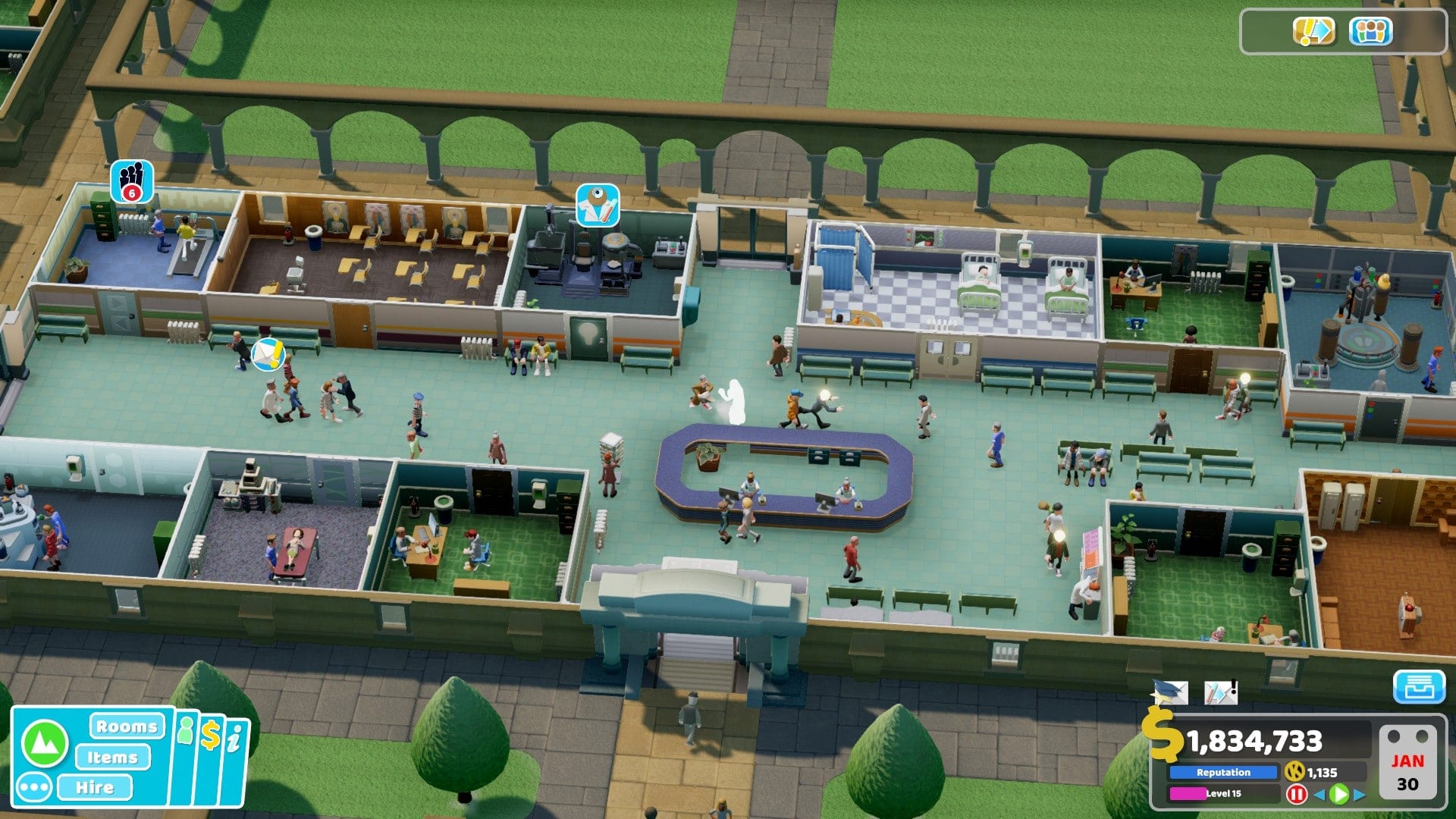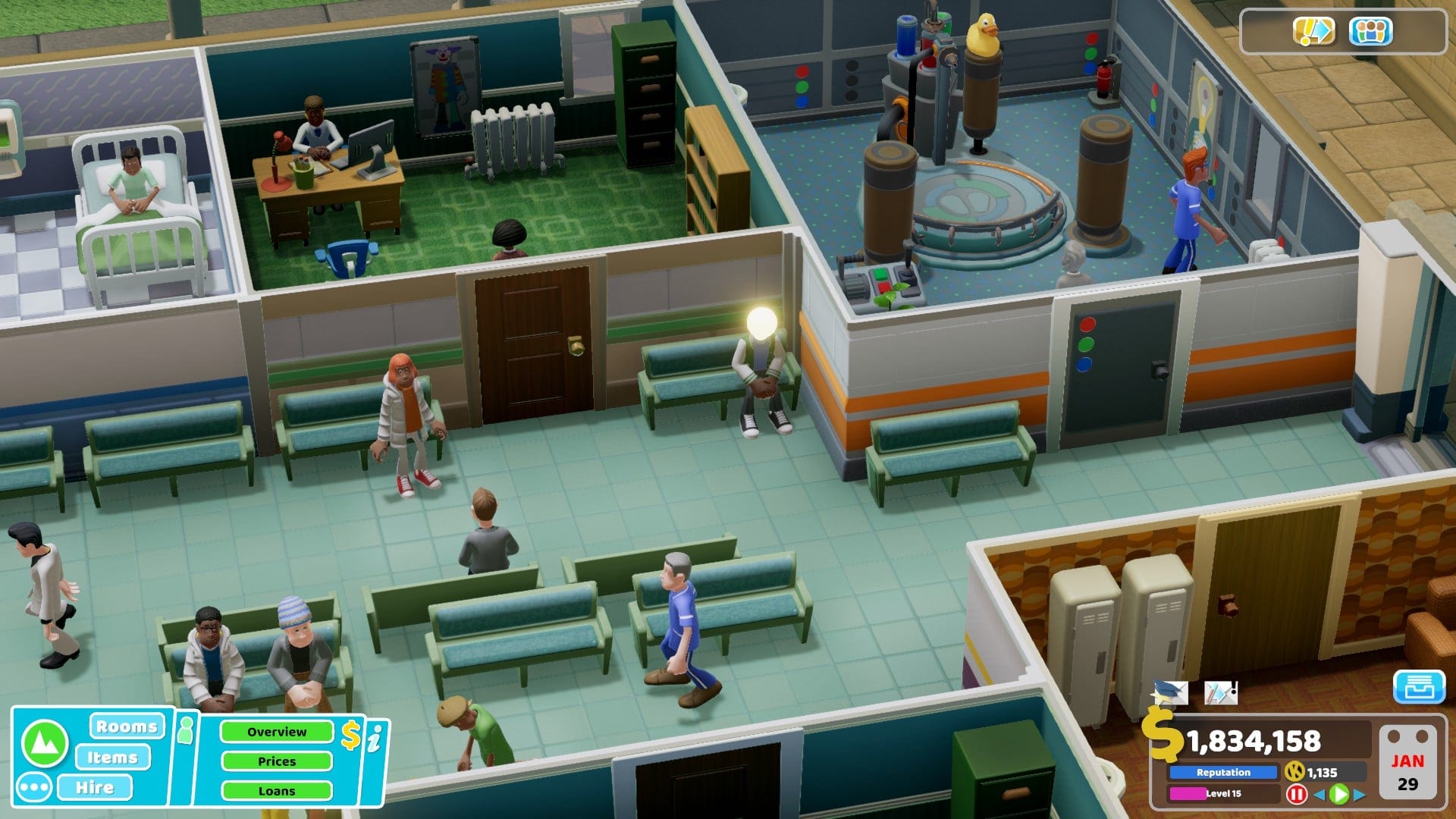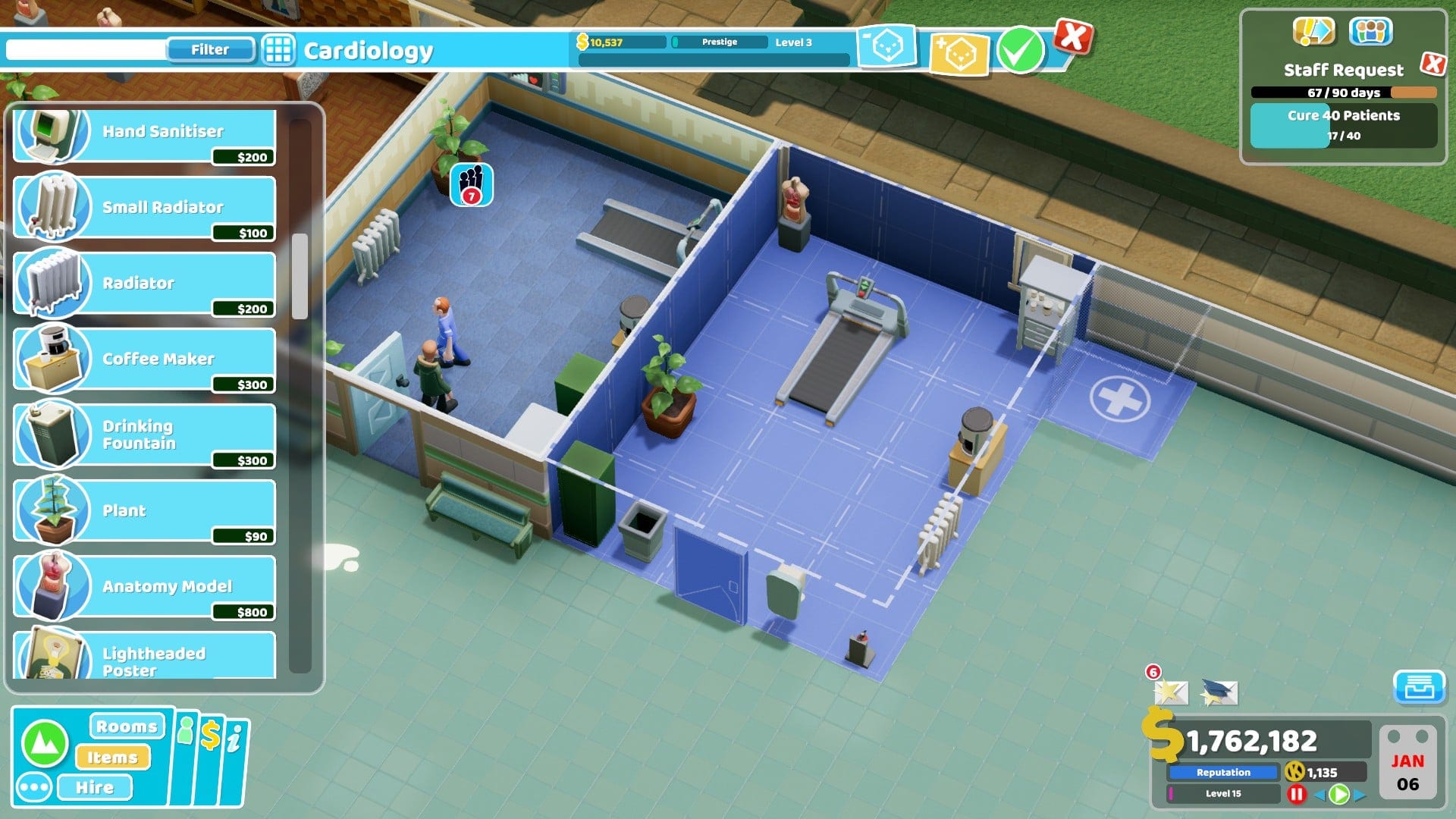I LOVED Theme Hospital when I was younger; I poured many hours of my childhood into building the most prestigious, profitable, attractive hospital and then sitting back and watching inflated heads get popped left, right and centre. Equally, I poured hours upon hours into Theme Park. In fact, I absolutely hammered almost all games that Bullfrog created, from Dungeon Keeper to Theme Park World. I was genuinely upset when Bullfrog merged with EA, who then proceeded to essentially shut the studio down (as they did with Westwood).
There was a glimmer of hope for Dungeon Keeper when ‘War for the Overworld’ appeared on Kickstarter and was, of course, fully funded. However, on release it wasn’t as I expected – it wasn’t Dungeon Keeper. They tried being too fancy, they added way too many ‘features’ which essentially turned it into a completely different game and, in my opinion, not a very good one – I know a lot of people liked the game, and maybe I would have too if they had kept Dungeon Keeper’s legacy out of it.
And now we have Two Point Hospital, which—if you’ve only seen screenshots and gameplay videos—looks just like Theme Hospital, but modernised; not ruined by new features and developers trying to get too clever, and honestly, that’s what you get with the game, and I love it.

The way Two Point Studios have stuck to the script and have not deviated far from what made Theme Hospital so great is to be applauded, of course there are new parts to the game such as improved graphics, new items and new illnesses, but these are things that you would expect from a spiritual sequel, unlike what the developers did with what was tipped to be Dungeon Keeper 3. This is down to the fact that previous Bullfrog employees and creators of the original Theme Hospital game—Mark Webley and Gary Carr—are at the helm of Two Point Studios.
When you first start up Two Point Hospital you’ll be hit with an instant dose of nostalgia
When you first start up Two Point Hospital you’ll be hit with an instant dose of nostalgia; the same animated characters appear and even the menus feel similar. When you get around to actually starting the game it will hit even harder – the reception desk is the same, the way you drag the rooms out and a blueprint appears is still the same, you still have to furnish each room with the required items (even the required items for each room are the same) and what really tipped me over the edge was the tannoy, they still use—as far as I can tell—the exact same voice lines as the original and even the same voice – I’m not going to lie, it almost brought tears of joy to my eyes.
In essence, Two Point Hospital is the same game but with better graphics and more content, exactly what a spiritual sequel should be (Two Point Hospital is not officially a sequel) and I can’t thank Two Point Studios enough for letting me relive those great times playing Theme Hospital in my youth – you could easily have ruined many childhood memories of mine.
Anyway, that’s enough with my own personal hospital simulation love story (no that’s not weird, you’re weird), let’s go into more detail about the game.
As with Theme Hospital, the aim of the game (as is the aim in any hospital) is to cure patients of their illnesses. Of course, these aren’t just normal illnesses, these illnesses range from people with saucepans stuck on their heads to cube disease and ‘Light Headedness’’, which is literally patients with a light bulb for a head which you have to swap out for, well, an actual head. You’ll cure these diseases with some equally mental procedures, from swapping people’s heads to sending them to a circus (which, of course, cures clowns disease….duh).

As well as curing patients you also have to channel your inner Alan Sugar and manage your hospital properly, from hiring and firing staff, training them, managing loans, debts and research and of course making your hospital a pleasant place for people to visit by furnishing your hospital throughout. Keeping it clean and ensuring patients have places to eat and drink is also absolutely vital. There’s one thing you can’t do though, and that’s build the outer walls for your hospital. Instead, like the original game, you are given a ready-made building in which you have to build rooms – although it would be cool to actually build your hospital from scratch so that you can decide the shape and size, by not allowing you to do this it adds another challenge to gameplay – making everything that you need fit in the allocated space and prioritising what you put in first before you can expand.
If you’re unable to accomplish any of the above there will be consequences (queue ominous music). For example, if you let your hospital get too dirty by not employing enough janitors, ‘Monobeasts’—which are essentially rats—will appear and you have to shoot them. If you don’t train your staff enough, people will start to die and your reputation drops, and of course if you get into debt you go bankrupt. That’s how finances work.
The game is set out like a campaign. There are multiple locations/hospitals for you to take on and build up and you will progress to the next location once you have gained a one star rating for the hospital you are playing on, it’s then your choice when you want to move on – you’re never forced to. You’re able to return to previous hospitals at any time in order to try and get three stars on each (which is the maximum), so once you have unlocked new rooms you can go back and add these rooms to your other hospitals.

The staff management area has had an overhaul – you can now specify which Doctor or Nurse can perform which job (similar to the system used in Rimworld) – this means that you can train staff so that each member will have a specialisation, which in turn increases your cure rate and speed of diagnosis. This is a great addition for the game as it allows you to run the hospital much more efficiently, and that gets me to my next point. On the face of it the game may seem easy (in some ways it is, which I will touch on later), but it’s one thing having a hospital with all of the rooms and tonnes of money, the real achievement however, is running an efficient hospital where all patients and staff are happy, where your cure rate is 90%+ and you’ve won every award at the yearly awards ceremony – and these things are a lot harder to achieve.
One example of this efficiency that I’m talking about is the GPs office. I see many people complaining about long queues outside the GPs office—which, quite frankly, is incredibly realistic—however, this can be overcome by simply spreading out your GP offices – this is because at every stage of a patient’s treatment they return to a GP, so for more complex illnesses a patient might visit the GP 3 or 4 times per visit, and if you have a hospital setup like most new players do with the GPs mostly in the same building as the reception, you’re slowing down people getting to diagnosis and are causing even more of a backlog.
There are a few negative points which are stopping us giving this game a 10/10
With all of the good news out of the way, there are a few negative points which are stopping us giving this game a 10/10 – firstly, I’m going to start with some repetitiveness issues. The tannoy—although funny—is obviously looping through only a handful of voice lines, so hearing the same thing over and over, especially when playing for hours on end can get a bit annoying (I would liken it to spending an evening with my wife, but that would get me into serious trouble). The same goes for the music—or Two Point Radio as they call it—which is obviously a budget radio since they don’t have many tracks.
Secondly, there is no way to save a room layout as a preset, this means that every room you build has to be built again from scratch when you need another. This isn’t a massive issue at first, but as your hospital gets busier you’ll need multiple rooms. Let’s say, for example, you have 4 GPs offices in each of your hospitals and you’re on the 10th level – that’s 40 GPs offices you’ve already built and you’re not even at the end of the game, and on some levels you’re going to need more than 4. Usually I build the rooms in the same way each time as I know what to put in to raise the prestige level of the rooms, so that’s 40 rooms at a minimum that I’ve manually built and manually furnished in exactly the same way – it gets pretty frustrating and sometimes I just don’t bother furnishing them and take the hit on productivity until I can be bothered to go back to being an interior designer.

Also, some will be disappointed to find that there’s no sandbox mode in the game, which is a bit strange for a tycoon game like this, but as mentioned previously you do have the ability to go to any of your hospitals at any time, so the whole game is kind of like a sandbox since you can simply spend all of your time at one hospital if you so wish. However, by doing this you won’t be able to unlock all of the rooms, as you seem to only be able to research new rooms once you’ve moved onto the next hospital. This means that it’s not technically a sandbox game until you’ve unlocked all of the hospitals, but if you rush through getting one star on each this shouldn’t take too long.
The main thing that is holding this game back from getting a 9 or 10 is the difficulty
Finally, the main thing that is holding this game back from getting a 9 or 10 is the difficulty – at the moment it’s way too easy. The reason it’s easy is because money is never an issue, at the start of each hospital you can literally pause the game, spend most of your money building the first set of rooms and furnishing them with the best items, then hire the best doctors and within 20 minutes of play time you’ll be rolling in money again (and if not you can take the 150k loan which will tide you over until your hospital has found its feet). There needs to be less of a reward for curing and diagnosing patients so that you actually have to watch your money, because at the moment I just build and hire the most expensive staff without even worrying about my finances. I understand that it’s not trying to be a full on simulation game, but even in the original game I remember going bankrupt a few times – they could at least add some difficulty presets i.e. easy, medium, hard for those of us who want more of a challenge, because at the moment I feel like Bill Gates.
I can see that they have tried to add a bit of a challenge in as you progress further through the game – eventually earthquakes begin to hit your hospital and damage your machinery, but this is easily countered by simply hiring more janitors and there’s hospitals that don’t pay you for treatments but instead pay you for hitting goals which aren’t exactly difficult to complete. As of yet I’m unsure how you actually lose the game; I seem to remember from the original game that you could game over by having a cure rate/death rate that was too low/high (respectively) and going bankrupt – assuming that this is still the same in Two Point Hospital, the difficulty of this has really been toned down because my cure rate is always pretty high, as is my bank balance.
Overall my time playing the game was thoroughly enjoyable
So, although there are some negative points in Two Point Hospital, overall my time playing the game was thoroughly enjoyable and I genuinely look forward to booting it up when I have some spare time. If they could get the issues I mentioned above sorted, I would not have an issue giving this game a 10/10, it would deserve it and I would take the time to come back here and change the score myself. At the moment though, although I would still say that it’s the best tycoon game to be released for a long time, it’s few minor shortcomings have led me to settle on a score of 8/10.
To end the review I would like to say thank you to Two Point Studios again for bringing back such fond memories from my childhood and building upon a game that many people loved, while at the same time staying true to its roots.
